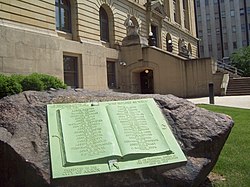Summit County, Ohio
| Summit County, Ohio | ||
|---|---|---|

Summit County Courthouse
|
||
|
||
 Location in the U.S. state of Ohio |
||
 Ohio's location in the U.S. |
||
| Founded | March 3, 1840 | |
| Named for | the highest elevation on the Ohio and Erie Canal | |
| Seat | Akron | |
| Largest city | Akron | |
| Area | ||
| • Total | 419.38 sq mi (1,086 km2) | |
| • Land | 412.08 sq mi (1,067 km2) | |
| • Water | 7.3 sq mi (19 km2), 1.7% | |
| Population | ||
| • (2010) | 541,781 | |
| • Density | 1,313/sq mi (507/km²) | |
| Congressional districts | 11th, 13th, 14th, 16th | |
| Time zone | Eastern: UTC-5/-4 | |
| Website | www |
|
Summit County is an urban county in the U.S. state of Ohio. As of the 2010 census, the population was 541,781 making it the fourth-most populous county in Ohio. Its county seat is Akron. The county was formed on March 3, 1840, from portions of Medina, Portage and Stark Counties. It was named "Summit County" because the highest elevation on the Ohio and Erie Canal is located in the county.
Summit County is part of the Akron, OH Metropolitan Statistical Area, which is also included in the Cleveland-Akron-Canton, OH Combined Statistical Area.
According to the U.S. Census Bureau, the county has a total area of 419.38 square miles (1,086 km2), of which 412.08 square miles (1,067 km2) is land and 7.3 square miles (19 km2) (1.7%) is water. The largest portion of Cuyahoga Valley National Park is located in the northern part of the county. The southern border of the former Connecticut Western Reserve passes through the southern part of the county, leading to jogs in the east and west borders of the county.
Summit County, along with Cuyahoga County, is one of two of Ohio's 88 counties that have a charter government, as authorized by the Article X of the Ohio Constitution. Under its charter, rather than three elected commissioners, Summit County has an elected County Executive and an eleven-member County Council. Eight members of the council are elected from individual districts the other three are elected at large. Summit County also has an appointed Medical Examiner rather than an elected Coroner, and an elected Fiscal Officer, who exercises the powers and performs the duties of a county auditor, treasurer and recorder. The remaining officials are similar to the officials in other counties. They include the following:
...
Wikipedia

